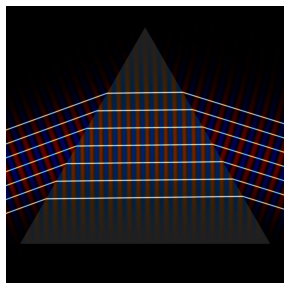2.2. Refraction: prism#
In this section, we explore refraction using a prism rather than a lens refraction by a lens, LensRefraction.ipynb. Note that, as previously, the propagation code is paraxial so we can expect significant errors when the angle between the propagation direction and the surface normal is greater than about 30 degrees.
In terms of physics, refraction by a prism is simpler because there is only one angle of incidence.
In terms of the core of the code, they are the same.
Next, we present the code.
The Jupyter Notebook is PrismRefraction.ipynb see
import matplotlib.pyplot as plt
import numpy as np
import time
from numpy.fft import fft, ifft, fftshift
This cell defines a few functions. We shall use Line for rays and Triangle for a prism.
def Rectangle(x,y,x0,y0,a,b,rotation):
xa = (x-x0)*np.cos(rotation) + (y-y0)*np.sin(rotation)
ya = (y-y0)*np.cos(rotation) - (x-x0)*np.sin(rotation)
return (xa > (-a/2)) & (xa < (a/2)) & (ya > (-b/2)) & (ya < (b/2))
def Line(x,y,x1,y1,x2,y2,a):
x0 = x1
y0 = y1
b = np.sqrt((x1-x2)**2 + (y1-y2)**2) # length of line
rotation = -np.arctan((x2-x1)/(y2-y1))
xa = (x-x0)*np.cos(rotation) + (y-y0)*np.sin(rotation)
ya = (y-y0)*np.cos(rotation) - (x-x0)*np.sin(rotation)
return (xa > (-a/2)) & (xa < (a/2)) & (ya > (0)) & (ya < (b))
def GBeam(zb,yb,z0,y0,beamsize,angle):
angle = angle
za = (zb-z0)*np.cos(angle) + (yb-y0)*np.sin(angle)
ya = (yb-y0)*np.cos(angle) - (zb-z0)*np.sin(angle)
zR = np.pi*beamsize**2
q = za-1.j*zR
return (-1.j*zR*np.exp(2*np.pi*1.j*(za+ya*ya/(2*q)))/q)
def Ray(zb,yb,z0,y0,beamsize,angle):
angle = angle
za = (zb-z0)*np.cos(angle) + (yb-y0)*np.sin(angle)
ya = (yb-y0)*np.cos(angle) - (zb-z0)*np.sin(angle)
return (np.exp(2*np.pi*1.j*za-(ya/beamsize)**2))
def Triangle(x,y,x0,y0,size,angle):
return ((-y-y0 + size/(2*np.cos(angle/2))-np.tan(angle)*(x-x0) > (0))
& (-y-y0 + size/(2*np.cos(angle/2))+np.tan(angle)*(x-x0) > (0))
& (-y-y0 + size/(2*np.cos(angle/2)) < (size*np.cos(angle/2))))
def Circle(x,y,x0,y0,r):
xa = x-x0
ya = y-y0
return (xa*xa + ya*ya < (r*r))
Next we define a grid in units of the wavelength. \(dy\) and \(dz\) are the spatial resolution. \(\lambda/50\) for the values given below.
zmin = 0 # z is the horizontal axis so like x in cartesian system
zmax = 20
ymin = -8 # vertical axis coould be x or y, call it y to agree with standard axes
ymax = 12
dz = 0.02
dy = 0.02
zoom = 1
Z, Y = np.mgrid[zmin/zoom:zmax/zoom:dz/zoom,ymin/zoom:ymax/zoom:dy/zoom]
z_pts, y_pts = np.shape(Z)
This is the \(k\)-space grid.
kymax=1.0*np.pi/dy
dky=2*kymax/y_pts
ky=np.arange(-kymax,kymax,dky) # fourier axis scaling
ky2=ky*ky
ky2c=ky2.astype('complex') #Notes on complex types http://www.scipy.org/NegativeSquareRoot
k=2.0*np.pi # k=2pi/lambda with lambda_0=1
k2=k*k
kz=np.sqrt(k2-ky2c)
This is the propagation phase the appear in the hedgehog equation.
ph=1.0j*kz*dz
We define triangle that will become our prism
PSize = 18
PAngle = 60*np.pi/180
PCentre = PSize/(2*np.cos(PAngle/2))
PWidth = PSize*np.sin(PAngle/2)
Prism = Triangle(Z,Y,zmax/2,0,PSize,PAngle)
This cell defines the parameter of the plot. The refractive index of the prism. The input beam size and propagation angle.
Index = 1.5
BeamSize = 3
BAngle = 20*np.pi/180
BeamOffset = 0
The next cell creates the image. The first few lines initialise the RGB grid, then we add the prism and a gaussian beam in the input plane. The hedgehog equation propagation propagates the field Next we add the result, either the electric field or the intensity into the RGB channels.
The rest of the code is to add rays.
E_or_I = "Field"
Rays = "Rays"
R = np.zeros((z_pts,y_pts))
G = np.zeros((z_pts,y_pts))
B = np.zeros((z_pts,y_pts))
NR = np.zeros((z_pts,y_pts))# refractive index
NR += (Index-1)*Prism
E0 = GBeam(Z[0,:],Y[0,:],0,BeamOffset,BeamSize,BAngle)
b = fftshift(fft(E0))
for jj in range (0,z_pts): # propagat
c = ifft(fftshift(b)) * np.exp(2.0j*np.pi*NR[jj,:]*dz)
b = fftshift(fft(c)) * np.exp(1.0j*kz*dz)
if (E_or_I == "Field"):
R[jj,:] += 0.4*c.real
B[jj,:] -= 0.4*c.real
if (E_or_I == "Intensity"):
G[jj,:] += 0.2*(abs(c)*abs(c))**0.5
fig, (ax1) = plt.subplots(1,1,figsize=(6, 6),dpi=60)
if (Rays == "Rays"):
for RayDisp in range (-3,4,1):
BeamOff = 0
ZR1 = 0
YR1 = BeamOffset + RayDisp
ZR2 = ( - PCentre + YR1 + zmax/2*np.tan(PAngle) - ZR1*np.tan(BAngle))/(np.tan(PAngle)-np.tan(BAngle))
YR2 = YR1 + (ZR2 - ZR1) * np.tan(BAngle) # eqn or incomping ray
Theta_i = np.pi/2 - PAngle + BAngle
Theta_t = np.arcsin(1/Index*np.sin(Theta_i))
BAngle2 = - (np.pi/2 - PAngle) + Theta_t
ZR3 = ( - PCentre + YR2 + zmax/2*np.tan(-PAngle) - ZR2*np.tan(BAngle2))/(np.tan(-PAngle)-np.tan(BAngle2))
YR3 = YR2 + (ZR3 - ZR2) * np.tan(BAngle2) # eqn or incomping ray
Theta_i = np.pi/2 + PAngle + BAngle2
Theta_t = np.arcsin(Index*np.sin(Theta_i))
BAngle3 = - (np.pi/2 - PAngle) + Theta_t
ZR4 = zmax
YR4 = YR3 - (ZR4 - ZR3) * np.tan(BAngle3) # eqn or incomping ray
RayBefore = (-Y + PCentre + np.tan(PAngle)*(Z-zmax/2) < (0))
RayInside = ((-Y + PCentre + np.tan(PAngle)*(Z-zmax/2) > (0))
& (-Y + PCentre - np.tan(PAngle)*(Z-zmax/2) > (0)))
RayAfter = (-Y + PCentre - np.tan(PAngle)*(Z-zmax/2) < (0))
R1 = Ray(Z,Y,ZR1,YR1,0.05,BAngle) * RayBefore
Intensity = R1.real * R1.real + R1.imag * R1.imag
R += Intensity
G += Intensity
B += Intensity
R2 = Ray(Z,Y,ZR2,YR2,0.05,BAngle2) * RayInside
Intensity = R2.real * R2.real + R2.imag * R2.imag
R += Intensity
G += Intensity
B += Intensity
R3 = Ray(Z,Y,ZR3,YR3,0.05,-BAngle3) * RayAfter
Intensity = R3.real * R3.real + R3.imag * R3.imag
R += Intensity
G += Intensity
B += Intensity
R+=0.25*(Index-1)*Prism # add prism to final image
G+=0.25*(Index-1)*Prism
B+=0.25*(Index-1)*Prism
br=1.0
bg=1.0
bb=1.0
R=np.clip(br*R,0.0,1.0)
G=np.clip(bg*G,0.0,1.0)
B=np.clip(bb*B,0.0,1.0)
RGB=np.dstack((np.flipud(R.T), np.flipud(G.T), np.flipud(B.T))) # use transpose to swap image axes, flipud to origin at bottom left
ax1.imshow(RGB)
ax1.set_axis_off()

